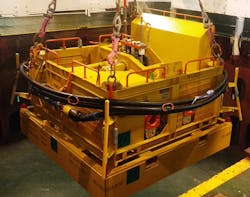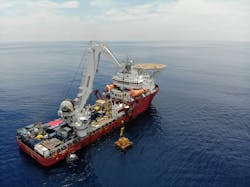Open-water hydraulic access improves economics of subsea well intervention
In a risk-averse market environment, offshore oil and gas operators are seeking opportunities to increase production or extend it for as long as possible with minimal outlay or with fast payback durations.
Well interventions enable operators to improve production from their existing assets; however, the cost-benefit of the job is not always economically justifiable for the well. This is because the subsea well intervention market has historically centered on rig-based activity, providing a high level of functional capability but at a higher daily running cost. Riserless light well intervention (RLWI) systems offer a cost-efficient alternative to traditional semisubmersible drilling rigs or drillships, but even these methods may not offer the most economic option depending on the type of intervention required.
A rig or RLWI system is generally required for a mechanical intervention to clean out debris or repair a damaged wellbore. However, it is not always needed for acid stimulation, scale squeeze, flowline flushing, well kill or rapid response jobs such as hydrate remediation that simply require transferring chemicals from the wellhead to the reservoir or flowline. In many cases, these types of jobs can be achieved using open-water hydraulic access (OWHA) intervention. This is especially applicable for scenarios where enough well and subsurface information or knowledge of a previous intervention treatment’s effectiveness is available, negating the need for further diagnostics such as production logging.
An OWHA system’s typical major components are a fluid conduit and a subsea safety module providing the necessary emergency isolation and disconnect functions from the subsea asset. Since OWHA interventions are less complex than jobs requiring mechanical intervention, they do not need a high-specification rig. They need a vessel with simplified subsea well access equipment that can still accommodate the job, including an ROV or dive support and heave-compensated subsea crane. This enables operators to benefit from access to a wider fleet of vessels (e.g., vessels of opportunity), such as multi-purpose vessels (MPVs). Operators may even spot hire a vessel for the job scope or, in some advantageous scenarios, increase the utilization of their existing long-term chartered vessels that are already contracted for typical installation, maintenance, and repair scopes. The result is a fit-for-purpose intervention solution that, for most projects, converts wells that were once not economically viable for intervention to prime candidates for intervention.
This article focuses on the scenarios where OWHA interventions can provide the best return on investment (ROI), the technologies and approaches that can be used for these interventions, and proven success in both shallow and deepwater environments.
The economic argument
With budgets stretched, it is more important than ever for production engineering teams to find cost-efficient ways of conducting well intervention projects that drive the strongest possible returns. By implementing the OWHA technique instead of a riser-based or RLWI approach, large cost and time efficiencies can be realized. There are two factors with an OWHA intervention that contribute to a reduction in vessel-related spend. The first is reduced vessel requirements permit use of a simpler, nonspecialized specification that can be efficiently sourced in any region. For example, an MPV rather than a purpose-built intervention vessel. The second is the simplified equipment setup results in a substantial reduction in deployment and recovery time offshore.
In circumstances where OWHA satisfies the operational brief it can deliver maximized injection flow rate, thus increased production enhancement when compared to riser-based intervention. Pumping through coiled tubing (CT) from topsides to the reservoir has more of a constrained flow area compared to a downline from topsides to the subsea tree then entering the production tubing at the subsea tree to the reservoir. The reduced frictional losses experienced within an OWHA configuration maximize the achievable pumping rate, providing an opportunity for improved diversion and reservoir productivity upside.
Using average global vessel rates and generalized assumptions cited by Avery et al. (2020), the total costs of a well intervention are as follows: floating rig $9-16 million, light well $6-10 million, and OWHA $2-5 million. Using an average well production gain of 1,950 b/d this gives a typical payback time period of about nine months for a rig and three months for OWHA.
Technologies and approaches
Shallow-water assets can be intervened by using an industrial hose as the fluid conduit. However, due to physical limitations at a certain water depth, alternative conduit material types can enable a more practical or efficient deepwater hydraulic intervention, such as the use of composite or CT materials.
For CT conduit systems, a choice exists between using a vendor’s existing fleet of standard CT equipment, such as a powerpack, control cabin, reel, injector head and gooseneck, in combination with a deployment tower or a scope specific powered CT reeler system.
The subsea safety module (SSM), which typically provides a means to disconnect from the subsea asset both passively and actively, in addition to providing dual isolation that is fail safe closed, may often be landed in a clear seabed space adjacent to the subsea fluid access point. Depending on the seabed, the SSM may include an integral mud mat, suction pile, or similar structure.
Interface to the subsea asset may often be directed through a tree re-entry mandrel, MARS multiple application reinjection system insert retrievable chokes, hot stabs, or other temporary connection points often found at the subsea tree or manifold.
Case studies
Water injection wells within the Schiehallion field west of Shetland were suffering from reduced performance due to scale buildup in the reservoir. BP sought a cost-effective solution to deliver remedial treatments intended to remove the scaling and restore well performance. The operator chose an OWHA intervention using the OneSubsea subsea modular injection system (SMIS). This enabled BP to use an existing inspection, maintenance, and repair (IMR) vessel on contract in the field for the intervention operations, thus eliminating the requirement to source an additional vessel. Three wells were successfully intervened during 2018 and 2019, with plans for eight wells in 2020. By approaching their intervention in this way, BP realized a 30% cost saving over the conventional method of RLWI. Reservoir results included: observed clean-up in the near-well skin, significant injection rate increase, and injectivity improvements of up to 300%. The use of an open-water downline connected directly to the subsea infrastructure, rather than spotting fluids downhole, contributed to the 20,000 bbl of additional injectivity enabled at the field.
Murphy Sabah Oil Co., Ltd. and its joint venture partners had three deepwater subsea wells in the SNP field in blocks G and K off western Sabah in Malaysia. Located at water depths between 3,900 and 4,600 ft (1,200 and 1,400 m), the wells suffered from hindered production caused by scale formation and fine sand deposition inside the production tubing and in the formation. The complex geological profile of the formation included relatively low fracture pressures and a gravel pack completion type that restricted the ability to achieve isolation between producing zones using mechanical intervention tools.
The operator chose an OWHA intervention to deliver the required stimulation and scale squeeze job. The intervention was deployed using a subsea modular injection system, multiple application reinjection insert retrievable choke and CT downline.
The job was planned and mobilized to meet the challenging intervention window, with offshore operations completed in seven weeks. Three wells were intervened, achieving the core objectives with more than 10,000 bbl of fluid delivered.
Conclusion
Today, real-world examples have demonstrated the capability of OWHA to provide both reservoir productivity improvements and dramatic total intervention cost reductions when compared to alternative traditional intervention approaches, such as light well and riser-based intervention methodologies.
When a subsea well needs to deliver treatment fluids to the reservoir or flowline, OWHA enables operators to review their legacy preliminary budgeting tools, and in many cases achieve enhanced return on investments with accelerated payback durations.

